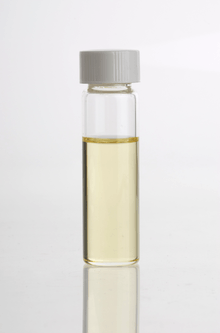Oil of clove

Oil of clove, also known as clove oil, is an essential oil extracted from the clove plant, Syzygium aromaticum. It has the CAS number 8000-34-8.
Clove oil is a natural analgesic and antiseptic, used primarily in dentistry for its main ingredient eugenol. It can also be purchased in pharmacies over the counter as a home remedy for dental pain relief, mainly toothache. It is also often found in the aromatherapy section of health food stores, and is used in the flavoring of some medicines. Madagascar and Indonesia are the main producers of clove oil.[1]
Clove oil is used widely in microscopical preparation, as it is miscible with Canada balsam, and has a similar refractive index to glass (1.53).
Oil of clove is also used as an ingredient in cat deterrent sprays, coupled with garlic oil, sodium lauryl sulfate, and other ingredients.
Types
There are three types of clove oil:[1]
- Bud oil is derived from the flower-buds of S. aromaticum. It consists of 60–90% eugenol, eugenyl acetate, caryophyllene and other minor constituents.
- Leaf oil is derived from the leaves of S. aromaticum. It consists of 82–88% eugenol with little or no eugenyl acetate, and minor constituents.
- Stem oil is derived from the twigs of S. aromaticum. It consists of 90–95% eugenol, with other minor constituents.
Uses
Clove oil has been promoted as having a wide range of health effects, but there is insufficient medical evidence to support general claims for its use as a therapeutic.[2]
Toothache
Particularly in South Korea and India, eugenol, a phytochemical extracted from clove oil, is used to relieve toothache.[3] Applied to a cavity in a decayed or extracted tooth, eugenol or clove oil can relieve toothache temporarily.[3][4][5] The potential mechanisms for how eugenol may inhibit dental pain are under active research.[6]
In the United States, the FDA considers eugenol ineffective for treating dental pain, and has downgraded clove oil as an analgesic due to insufficient evidence to rate its effectiveness.[2]
Use on fish
Clove oil is commonly used to anesthetize or euthanize laboratory or pet fish.[7][8]
Toxicity
Taking cloves or clove oil in large amounts may cause nausea, vomiting, abdominal pain, diarrhea, burns in the mouth and throat, sore throat, seizures, difficulty breathing, rapid heartbeat, sleepiness, intestinal bleeding, and liver or kidney failure.[2] More serious effects have been reported in young children, even with small doses.[2]
Regulation
In Germany, Commission E permits the sale and administration of clove oil as a medicinal herb.[9]
References
- 1 2 Lawless, J. (1995). The Illustrated Encyclopaedia of Essential Oils. ISBN 1-85230-661-0.
- 1 2 3 4 "Clove". MedlinePlus. NIH.
Clove oil and eugenol, one of the chemicals it contains, have long been used topically for toothache, but the FDA has reclassified eugenol, downgrading its effectiveness rating. The FDA now believes there isn't enough evidence to rate eugenol as effective for toothache pain.
- 1 2 Chung G, Oh SB (2013). Eugenol as local anesthetic. Springer-Verlag Berlin; In: Natural Products - Phytochemistry, Botany and Metabolism of Alkaloids, Phenolics and Terpenes; Part XIV. pp. 4001–4015. doi:10.1007/978-3-642-22144-6_171. ISBN 978-3-642-22144-6.
- ↑ Alqareer A, Alyahya A, Andersson L. "The effect of clove and benzocaine versus placebo as topical anesthetics". Journal of Dentistry 34 (10): 747–50. doi:10.1016/j.jdent.2006.01.009. PMID 16530911.
Both clove and benzocaine gels had significantly lower mean pain scores than placebos. No significant difference was observed between clove and benzocaine regarding pain scores.
- ↑ Jesudasan JS, Wahab PU, Sekhar MR (2015). "Effectiveness of 0.2% chlorhexidine gel and a eugenol-based paste on postoperative alveolar osteitis in patients having third molars extracted: a randomised controlled clinical trial". Br J Oral Maxillofac Surg 53 (9): 826–30. doi:10.1016/j.bjoms.2015.06.022. PMID 26188932.
- ↑ Seo H, Li HY, Perez-Reyes E, Lee JH (2013). "Effects of eugenol on T-type Ca2+ channel isoforms". J Pharmacol Exp Ther 347 (2): 310–7. doi:10.1124/jpet.113.207936. PMID 24014106.
- ↑ Gary Kent Ostrander (2000). The Laboratory Fish. Elsevier. pp. 508–. ISBN 978-0-12-529650-2.
- ↑ Gary West; Darryl Heard; Nigel Caulkett (21 July 2014). Zoo Animal and Wildlife Immobilization and Anesthesia. Wiley. pp. 249–. ISBN 978-1-118-79286-5.
- ↑ Rister, R.; Klein, S.; Riggins, C. (1998-08-15). The Complete German Commission E Monographs: Therapeutic Guide to Herbal Medicines (1st ed.). American Botanical Council. p. 112. ISBN 978-0-9655555-0-0.